Published July 21, 2023 at 9:14 a.m.
By Steve Schuster
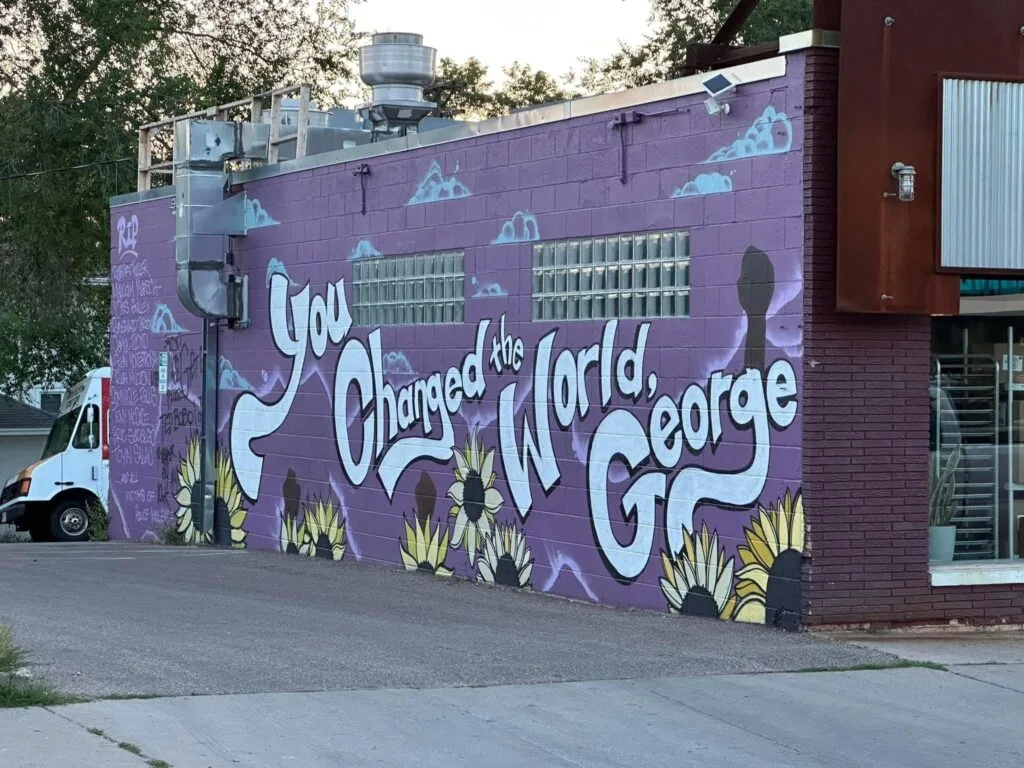
Minneapolis building painted in memorial of George Floyd. Staff Photo Steve Schuster
Since George Floyd’s death and the pandemic’s inception, Milwaukee shootings have nearly doubled, putting a further strain on doctors, first responders and lawyers who have yet to recover from the pandemic backlogs, officials tell the Wisconsin Law Journal.
In 2019, Milwaukee Police responded to 757 shooting calls for service. In 2021, the number had increased to 1,403, nearly doubling, according to newly obtained data from the Milwaukee Police Department by the Wisconsin Law Journal.
“That is a startling number,” said Milwaukee County District Attorney John Chisholm during an interview with the Wisconsin Law Journal on Thursday.
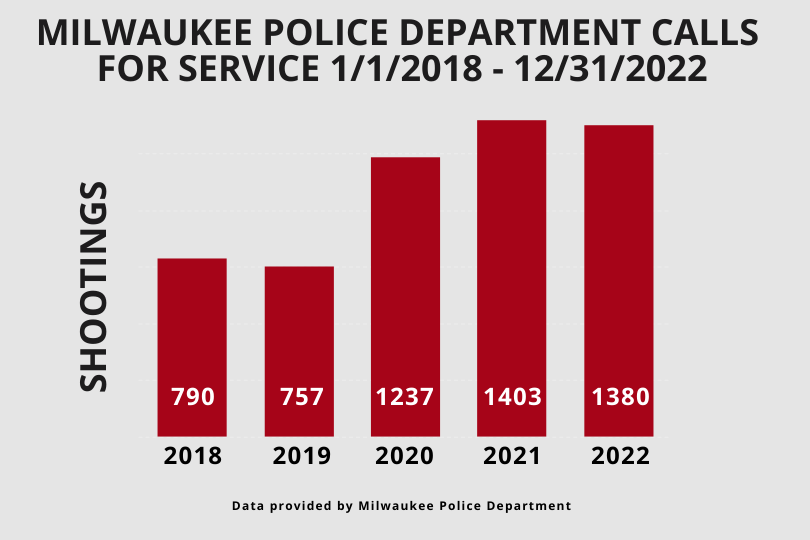
Calls for service for shootings 2018 -2022
Geospatial mapping also shows a sharp increase in shootings in 2021 on the Milwaukee Homicide Review Commission Dashboard.
Chisholm said, “In a historical context, the city has done a really good job over the past 20 years pushing that number down.”
Milwaukee Mayor Cavalier Johnson announced Thursday recently released crime stats (see below), including that homicides are down 31% when compared to this time last year.
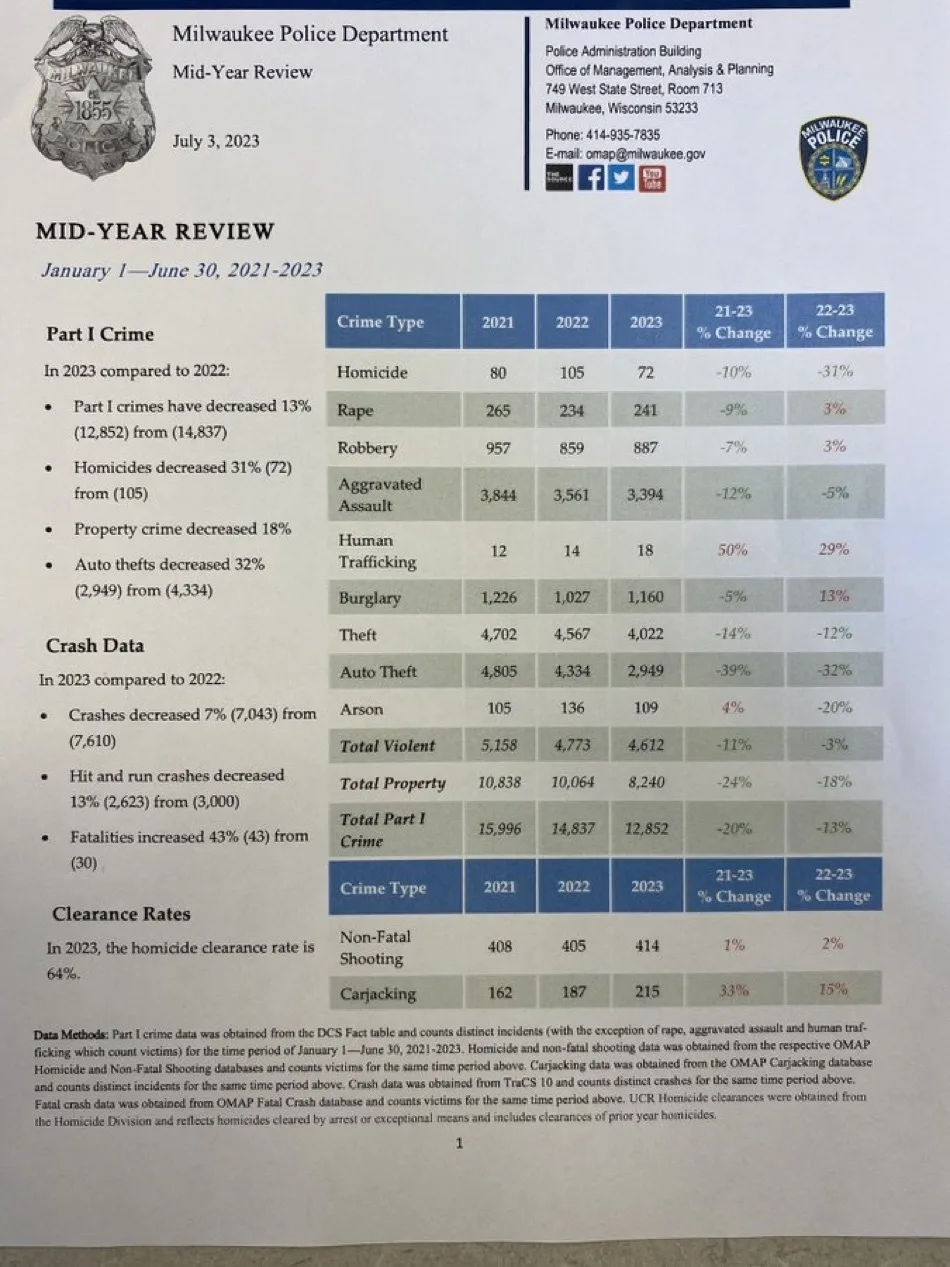
Number of confirmed shootings listed above, in comparison to the number of calls for service for shootings in the previous image.
According to FBI data obtained by the Wisconsin Law Journal, in 2005 the Milwaukee Police Department reported 121 homicides, that number dropped to 73 in 2009 and 86 in 2014.
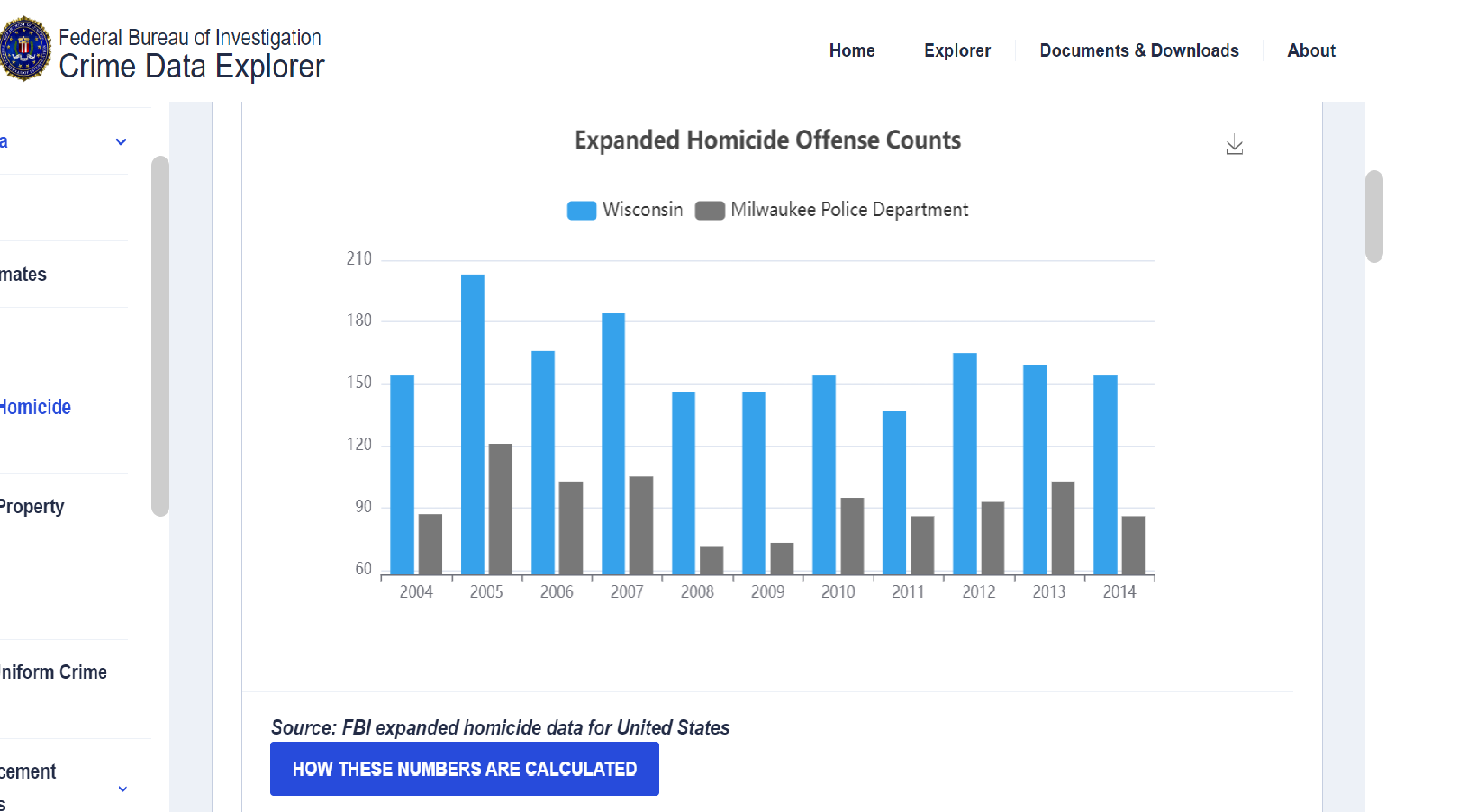
Source: Federal Bureau of Investigation
In Minneapolis, shots fired calls to police more than doubled from 2019 (2,255 calls) to 2022 (5,762 calls).

Source Minneapolis Police Department
After 2019 …. then came the pandemic, and the death of George Floyd. However, the challenges local law enforcement face on a daily basis does not end there.
“Keep in mind we have seen record number of overdose deaths, reckless driving incidents, traffic fatalities and calls for service for domestic violence,” Chisholm noted. Many of these incidents end up in the local emergency room.
Chisholm noted that non-fatal shootings aren’t that far away from being classified as a homicide.

“The reality is that non-fatal shootings are often a matter of being millimeters away from being designated as a homicide,” Chisholm said Thursday.
In June, Milwaukee Criminal Justice leaders gathered at a Milwaukee Press Club panel discussion to discuss crime reduction strategy as Minnesota prosecutors urged the Minnesota Supreme Court to reject former Minneapolis police Officer Derek Chauvin’s request for an appeal of his conviction for murdering Floyd.
During Milwaukee’s crime-fighting conversation, TMJ4’s Vince Vitrano said some Milwaukee police officers have told him they “police less aggressively” following the George Floyd protests, as the officers did not feel supported by the community, city hall, leadership or the Fire and Police Commission.
Vitrano then asked the assistant MPD chief if she witnessed this too.
Assistant Police Chief Nicole Waldner said she has “heard that a lot as well.”
Seeing the forest through the trees, Chisholm doesn’t pinpoint just one particular cause of the spike in shootings.
“If you have limited resources and overwhelming demand, things come close to breaking sometimes. I think that is what people are trying to manage. There is a fine line between making sure things are done appropriately and respectfully while managing overwhelming demand,” he added.
In the aftermath of Floyd’s death and the pandemic, first responders, attorneys and doctors are feeling the impact — and it’s significant.
Attorney Leah Thomas, a partner at the criminal defense firm Mastantuono Coffee & Thomas SC, noted that its volume of cases involving shootings has increased so much over the past few years they’ve hired more people to manage the increased caseload.
“We hired another associate attorney and a support staff position to handle the new influx of cases,” Thomas said during an interview with the Wisconsin Law Journal on Wednesday.
Hospitals are feeling the impact of more shootings as well as officials from southeastern Wisconsin’s only Level I Trauma Center also said during an interview with the Wisconsin Law Journal on Wednesday.
“Anybody that is shot and picked up by an EMS call, they are coming to Froedtert, noting that some other local hospital emergency rooms will get local walk-ins or drop-offs. Froedtert MCW is 100% feeling that increase in violence. We sit down at 7 a.m. every morning as the trauma team and discuss what happened overnight. It is a rarity that there are not multiple patients we are discussing who is a victim of gun violence,” said Dr. Libby Schroeder, an emergency department trauma surgeon at Froedtert and associate professor with the Medical College of Wisconsin.
When asked by the Wisconsin Law Journal how health care has changed since the death of George Floyd, Schroeder said, “I’m not sure I’m comfortable saying this is a George Floyd phenomenon. I think there are a lot of things happening in this country at one time. There was also COVID, which obviously highlighted a lot of the disparities that exist within this country and took away some of the economic means, particularly of those from lower socio-economic brackets who were hit really hard.
“This is so multi-factorial,” Schroeder added. “I would say that we are seeing on the health care side is, we’re tired. The last few years have been exhausting. You take the stress and isolation of the pandemic and then you add in these huge increases in crime and health care workers as whole are burnt out and stressed,” Schroeder added.

Milwaukee officials tell the Wisconsin Law Journal that public safety remains a priority.
“The last thing we want to hear from medical doctors is that they are overwhelmed with gunshot wounds. Or that the medical examiner is about to break because of too many overdoses and homicides,” Chisholm said.
“The ultimate reactive consequence is ending up in the emergency room or before the medical examiner. That’s exactly the space we want to get away from, by intelligently preventing these things,” Chisholm said, noting the goal is to be in a place “where police conduct proactive strategies. It’s just been near to impossible of a dynamic over last three years,” Chisholm added.
Chisholm noted that crime preventative programs shut down during the peak of the pandemic.
“Primary prevention services shut down. The result, disorder rose,” Chisholm said, specifically referencing the closure of the Sojourner Family Peace Center, which was forced to close down during the pandemic. “It was the one-stop location to intervene in lives of victims of family violence,” he added.
Sojourner Family Peace Center is the largest nonprofit provider of domestic violence prevention and intervention services in Wisconsin, serving nearly 8,000 clients each year, according to the organization’s website.
Health care and legal nexus
“One of my arguments has always been that the public safety system has to reflect more of the public health system. We have to make efforts to engage in a preventative space through intervention, not just being reactive. This is why I have early interventional programs and community prosecutions, which is hard to do when everyone is overwhelmed,” Chisholm said.
“(The) Milwaukee Police Department has been blocked into a reactive period just trying to respond to case after case. A good criminal case requires hours and hours of follow up. If the community is distrustful of MPD, then they officers will not get the same information and then it takes longer and longer to solve a case. Clearance rates go down,” Chisholm noted.
“Anybody that thinks the consequences of the pandemic are over, that’s just not going to happen overnight. It’s going to take us a long time to get there. Everyone has simply been overwhelmed,” Chisholm added.
Back in the Emergency Department, Schroeder said due to the increased volume and frequency of shootings, Froedtert has made changes to accommodate the increase in demand.
‘Because it’s so frequent, the hospital simply expects it now. We have our own dedicated operating room dedicated to trauma patients. The patients that need to emergently go to the operating room are predominantly gunshot wounds. So, the system knowing that it happens so frequently, is built to make sure we are always ready,” Schroeder noted.
“We always have blood available for transfusion. We have gotten to the point where we have two full trauma teams around during the day and two faculty in the building at night because it was just becoming so frequent that with only one of us in the building, we were having to call in a second partner because there were additional emergencies. Often there was a second gunshot wound that needed to go to the operating room. It wasn’t enough to have just one of us here, we had to have two (doctors),” Schroeder added.
Schroeder, who moved to Milwaukee from the D.C. area in 2020, noted that what is unique about Milwaukee is that Froedtert is the only Level I Trauma Center in southeastern Wisconsin.
Noting that she had spent the first part of her career working in D.C. where there are two hospitals with the Level I Trauma rating, “it was more of a weekly event (in D.C.) instead of a daily event (in Milwaukee) where we saw a gunshot wound,” Schroeder said.
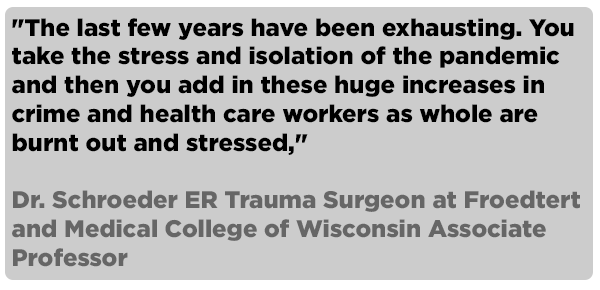
When asked if it’s good or bad that Milwaukee only has Level I Trauma Center, she said, “Personally I think it’s a good thing for the city to centralize all of that care allows us to develop wrap-around services for the population that we really worked on the past several years. This has been a lifelong passion for some of us in this division and one of the things that attracts people to this job. Because of that, when patients come here we have system set up for our gunshot wound survivors. We have social workers and nurse navigators that are working specifically with our gunshot wound survivors. Resources, that if it were spread out across the city, you probably wouldn’t be able to justify it. Our ICUS and emergency room are used to taking care of this type of patient population. I don’t think there is a need for an additional hospital.”
Schroeder also noted another thing that makes Milwaukee unique are the transit times.
“The transit times to get victims of gun violence in Chicago to a Level I Trauma Center are upward of 40 minutes to an hour. In Milwaukee, transit times average around 10-20 minutes. That’s the piece that saves lives, getting someone to a facility timely who can control hemorrhage and repair damage,” Schroeder said.
In the Milwaukee metro area patients are typically transported by ground via ambulance, however, in more rural parts of the state patients are transported by air via helicopter to Froedtert, she noted.
Specifically referencing the construction on I-43 and Highway 100, “there aren’t significant delays in terms of being able to get patients here,” she added.
The next closest Level 1 Trauma Center to the Milwaukee area is Madison or Libertyville, Illinois.
Health care providers are seeing a toll on patients beyond physical from the pandemic.
“In some ways we are realizing in 2023 that the pandemic is different now than it obviously was and COVID was not top of mind, but the effects of that on people’s mental health continue and as we move into a world that is so virtual it has been interesting to figure out ways to then connect on a human level, and that’s something in health care we are still feeling,” Schroeder said.
Schroeder noted that she was on her way post interview with the Law Journal to present to residents on a research study, changing way Froedtert runs its trauma resuscitation.
Schroeder said trauma resuscitations are currently laser focused on the physical health of patients.
“Yet we know more and more that 20-40% of patients develop post-traumatic stress disorder and that is higher in assaulted mechanism of trauma, particularly with gunshot wound victims,” Schroeder said.
“When a trauma comes in, we take all of their clothes off and examine them head to toe. There is somewhere between five to 15 people working them at one time. As you can imagine how traumatizing that is in addition to the trauma that they just experienced. So we are trying to introduce before all of that happens, saying ‘I’m here to take care of you, you’re in the right place and we are going to do everything we can to make sure you’re OK.’ That alone is a very novel concept in the way trauma centers are run across the country. And we at Froedtert are trying to change that, part of it is for the patient and part of it is for our staff to be reminded that these are humans and we can acknowledge that piece of what they are going (through) and puts us in a position to provide better care,” she added.
First responders are also dealing with increased shootings on a daily basis and it’s taking an emotional toll.
Some first responders say they are near a mental breaking point from the constant and increased volume of shootings, overdoses and reckless driving.
“The actual thing that hits in the core of the brain and in the heart of the firefighters and paramedics dealing with these things is the mother and the father standing there reeling from the core of their being in anguish and pain. You’re doing everything you can (to save them) and you’re not winning some of them,” said Aaron Lipski, Milwaukee Fire Department chief during the June Milwaukee Press Club event.
“That’s your work environment, over and over and over again. I’m not 100% certain of what people’s perceptions are of what firefighters and EMTs are capable of absorbing, but it isn’t this, not at this pace,” Lipski added, noting, “This is not a television show. … (We’re not at) the movies. These are things that are happening with a hair trigger,” Lipski added.
The spike in Milwaukee shootings also comes at a time when Wisconsin is on the brink of a constitutional crisis, as there are record vacancies for assistant district attorneys and public defenders.
In January, Wisconsin had 48 vacancies for district attorney positions, said State Bar of Wisconsin Past-Present Margaret Hickey during an interview with the Wisconsin Law Journal in March.
The result? The wheels of justice turn more slowly, according to Hickey, who noted, “the delay is important because the person who is accused of a crime has a right to speedy justice and there are victims who now have to wait for their justice. It’s very distressing for people to go to court and to find out that no hearing is happening today because of no public defender being available.”
“I think in 2020 what happened, the floor fell out. Everyone stopped. We (police) didn’t stop, but everybody else stopped, right? Courts barely functioned and now we have this tremendous backlog, which we are still not caught up,” Waldner said, noting that police are overburdened by calls for service and the courts lost so many court reporters.
As previously reported by the Wisconsin Law Journal, a pay increase for assistant district attorneys and public defenders passed the state’s Budget Committee in May.
Back in Wisconsin’s largest city, both criminal and civil attorneys expressed concern to the Wisconsin Law Journal over the backlogs in the local courts due to COVID.
When newly elected Milwaukee Bar Association President Emil Ovbiagele was interviewed by the Wisconsin Law Journal in June, he praised the work of Executive Director Sarah Martis and Past-President Judge Ellen Brostrom, of the Milwaukee County Circuit Court, who he said helped make a notable dent in solving Wisconsin’s Constitutional crisis — reducing the backlog of cases in Milwaukee County.
“Sarah worked tirelessly in reducing criminal backlogs at the Milwaukee County Courthouse,” he said in June.
“Due to COVID, you had folks charged with felonies and not having preliminary hearings for months and months,” Ovbiagele noted.
“Sarah (Martis) was able to galvanize our base with the help of our past-president (Judge Brostrom) and draw from the talent pool we have of members to try resolve this issue. We had civil attorneys take on limited-term (criminal law) engagements, and it made a significant dent into the issue.” Ovbiagele added.
As doctors, lawyers and first responders deal with the sharp rise in Milwaukee’s crime, the Milwaukee mayor is taking a green approach to crime fighting.
As previously reported by the Wisconsin Law Journal, Milwaukee Mayor Cavalier Johnson said there is a direct link between poverty, crime and climate change.
“There is a nexus between them all,” Johnson said in an interview with the Wisconsin Law Journal in Chicago last month.
“Poverty leads to violence and violence is crime. Where climate change comes into that nexus is the fact that in Milwaukee years ago, we had the highest quality of life for African-Americans in the United States. That’s because folks had access to good paying, family supporting careers in heavy manufacturing. Those jobs dried up and went to right-to-work states in the south, and they went overseas for cheap labor leaving those same neighborhoods — neighborhoods that I grew up in … quite frankly, sort of in the lurch, holding the bag where the people who lived there didn’t have access to those family and support opportunities,” Johnson said during June’s Chicago interview with the Wisconsin Law Journal.
Chisholm noted that Milwaukee officials are working relentlessly to get back to where we were pre-pandemic.
“Everyone is working incredibly hard to create that prevention intervention space again, and we are seeing some signs of that,” Chisholm said Thursday.
Back at Froedtert, Schroeder said the health care system has developed a SOS peer support program comprised of more than 300 staff members at every level to help cope with the stressors of the increased patient loads from shootings and other pain points.
“We receive several hours of training on how to support each other in mentally processing a death or bad patient outcome or difficult family interaction, and that program has really bosomed into something being utilized especially around this patient population, which can be so stressful. There is a lot going on at Froedtert to really address that side of things and bring the human side back in to medicine,” Schroeder said.


